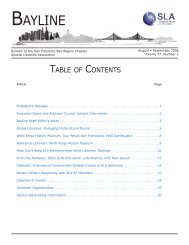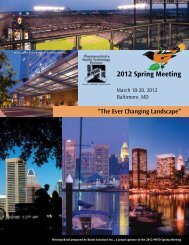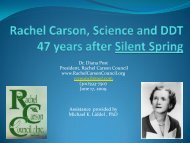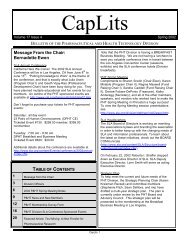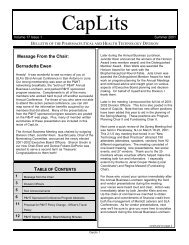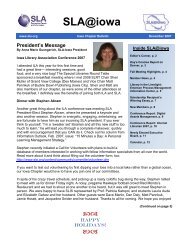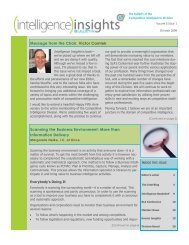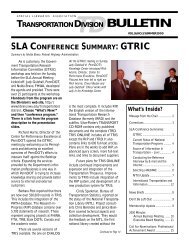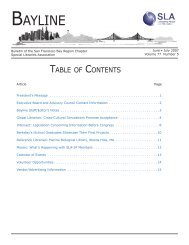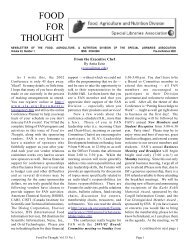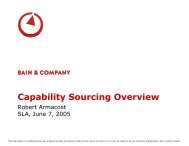Education Libraries - Special Libraries Association
Education Libraries - Special Libraries Association
Education Libraries - Special Libraries Association
You also want an ePaper? Increase the reach of your titles
YUMPU automatically turns print PDFs into web optimized ePapers that Google loves.
The structure of the course touches upon the<br />
resources provided by each of the three statewide<br />
cooperatives, with an emphasis on resources<br />
specific to teaching students PreK-12, but the<br />
skills teachers need to be information literate as<br />
graduate students are also addressed.<br />
From the onset, the course was designed to be<br />
practical. Each project was strategically designed<br />
in such a way that the teachers would be able to<br />
incorporate the end products in their classrooms<br />
with their students. Mechanisms have been created<br />
to share the reviewed work of the teachers with<br />
other educators throughout the state of Ohio.<br />
Feedback received over the years indicated that<br />
this sharing creates added value among the<br />
teachers because much of their graduate studies<br />
have taken a more theoretical approach.<br />
The course begins with an indepth<br />
overview of the structure<br />
of the information<br />
environment, an examination<br />
of the multiple definitions of<br />
information literacy, and the<br />
concept of transferable research<br />
skills from one online<br />
environment to the next. For<br />
most students it is the first time<br />
they have been asked to<br />
consider information retrieval in the context of the<br />
teaching and learning environment. In addition to<br />
understanding how information is organized on a<br />
large scale, students are introduced to general<br />
research concepts that are utilized in most online<br />
environments such as how to conduct keyword<br />
searches, when to use Boolean operators, and what<br />
truncation searches accomplish. Students practice<br />
the use of these search skills at length and are<br />
asked to intentionally use the skills throughout the<br />
course.<br />
The second module in the course includes an<br />
examination of the various information literacy<br />
models and the different standards expected to be<br />
incorporated into the projects throughout the<br />
course. In the first part of this module, the Big6 TM<br />
research model, created by Robert Berkowitz and<br />
Mike Eisenberg, is explored. According to their<br />
website, “Big6 is the most widely known and<br />
widely-used approach to teaching information and<br />
technology skills in the world.” (Big6 overview,<br />
2008) This research model is demonstrated in the<br />
course by using the example of purchasing a new<br />
automobile and includes research terminology<br />
familiar to educators. Students participate in an<br />
activity to compare and contrast additional<br />
research and information literacy models, and are<br />
challenged to consider adopting a particular model<br />
for students to use in their own classroom, thus<br />
seamlessly integrating information literacy<br />
principles into instruction. As each teacher’s<br />
school environment and access to library support<br />
differs dramatically, the benefits of having an<br />
entire grade, school or even school district adopt a<br />
particular model is discussed.<br />
For the second part of this module, students work<br />
intensively with the Ohio Academic Content<br />
Standards (Ohio, 2008). Through<br />
a hands-on, small group activity,<br />
students look for the presence of<br />
information literacy competencies<br />
in the academic content areas,<br />
technology standards and library<br />
guidelines, and then sort them<br />
strategically within the Big6 TM<br />
categories. Areas of overlap as<br />
well as deficiencies are identified<br />
and students examine approaches<br />
to addressing information literacy in<br />
interdisciplinary ways. Students are also<br />
introduced to the American <strong>Association</strong> of School<br />
Librarian’s Standards for the 21 st Century Learner<br />
(AASL, 2008), the Nine Information Literacy<br />
Standards for Student Learning (AASL, 1998) and<br />
the Information Literacy Competency Standards<br />
for Higher <strong>Education</strong> from the <strong>Association</strong> of<br />
College and Research <strong>Libraries</strong> (ACRL, 2008).<br />
By the third module, the final project is unveiled.<br />
At the end of the course, students are expected to<br />
build a WebQuest, which is an inquiry-based<br />
lesson in which most of the content utilizes online<br />
resources (Dodge, 2007.) This approach was<br />
popularized by Bernie Dodge at San Diego State<br />
University, and is utilized because of the model’s<br />
close alignment with information literacy<br />
competencies and research seeking behaviors. The<br />
rationale for using this model as a final project is<br />
<strong>Education</strong> <strong>Libraries</strong>, Volume 31, No. 2, Winter 2008 14



